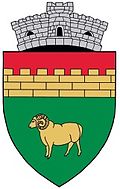Șugag
|
Șugag Schugag Sugág |
||||
|
||||
| Basic data | ||||
|---|---|---|---|---|
| State : |
|
|||
| Historical region : | Transylvania | |||
| Circle : | Alba | |||
| Coordinates : | 45 ° 46 ' N , 23 ° 38' E | |||
| Time zone : | EET ( UTC +2) | |||
| Height : | 457 m | |||
| Area : | 253.11 km² | |||
| Residents : | 2,726 (October 20, 2011) | |||
| Population density : | 11 inhabitants per km² | |||
| Postal code : | RO-517775 | |||
| Telephone code : | (+40) 02 58 | |||
| License plate : | FROM | |||
| Structure and administration (as of 2016) | ||||
| Community type : | local community | |||
| Structure : | Șugag, Arți , Bârsana , Dobra , Mărtinie , Sidoştina , Tău-Bistra | |||
| Mayor : | Constantin Jinar ( PNL ) | |||
| Postal address : | Str. Principală, no. 232 loc. Șugag, jud. Alba, RO-517775 |
|||
| Website : | ||||
| Others | ||||
| City Festival : | In May, "Zi bade cu fluiera" (the shepherd's festival, musician with the flute ) | |||
Șugag [ ˈʃugag ] ( German Schugag , Hungarian Sugág ) is a Romanian community in the Alba district in Transylvania .
Geographical location
The municipality of Șugag is located in the under forest in the south of the Alba district. Between the Șureanu Mountains (Mühlbach Mountains) and the Cindrel Mountains (Zibins Mountains ) on the upper reaches of the Sebeș (Mühlbach) - a left tributary of the Mureș - the approximately 6 kilometers long mountain village lies between the Căpâlna- (Lacul Căpâlna) in the north, and the Tău-Bistra reservoir (Lacul Tău-Bistra) in the south. At Drum național 67C - the so-called Transalpina - the place Șugag is 27 kilometers south of Sebeş (Mühlbach) ; the district capital Alba Iulia (Karlsburg) is 44 kilometers north of Șugag.
The Transalpina or the "King's Path" (Drumul Regelui) - only partially asphalted - is the highest national road in Romania in the Transylvanian Alps at Pasul Urdele ( 2145 m ) .
history
In the area of the place - on an area called Vârful lui Pătru by the locals - there are the ruins of a Roman fort.
The place Șugag as such was first mentioned in 1750 under the name Schugag .
Today the inhabitants live mainly from cattle breeding (especially sheep) and wood processing.
population
The population of the municipality developed as follows:
| census | Ethnic composition | |||||||
|---|---|---|---|---|---|---|---|---|
| year | population | Romanians | Hungary | German | other | |||
| 1850 | 1,222 | 1,215 | - | - | 7th | |||
| 1900 | 2,084 | 2,070 | 10 | 2 | 2 | |||
| 1941 | 2,276 | 2,273 | - | - | 3 | |||
| 1977 | 6,925 | 6,676 | 215 | 27 | 7th | |||
| 2002 | 3,239 | 3.211 | 25th | 2 | 1 | |||
| 2011 | 2,726 | 2,628 | 8th | - | 90 | |||
The highest number of inhabitants in today's municipality - both Romanians and Hungarians - was determined in 1977 and has fallen dramatically since then. The highest population of Germans (33) was registered in 1920 and that of Roma (7) in 1850. In addition, two residents identified themselves as Ukrainians in 1900, one each in 1910 and 1977, and one as Slovak in 1966 .
Attractions
- The Romanian Orthodox Church of Șugag.
- The ugag Municipality Village Museum.
- The Țeț monastery ( Sfântul Mare Mucenic Gheorghe ), built in 1955. A wooden church and living quarters were built on the site of the monastery in 1979–1999. 25 nuns live in the monastery, 25 kilometers south of the village of Șugag.
- The Oașa monastery ( Adormirea Maicii Domnului and Sfântul Mare Mucenic Pantelimon ), whose wooden church was rebuilt here in 1983 because of the Fetița reservoir , is located about 42 kilometers south of Șugag. Located at an altitude of about 1400 m, the monastery was originally inhabited by nuns; Because of the difficult access - mainly in winter - 20 monks have lived in the monastery since June 1, 2000.
Web links
Individual evidence
- ↑ 2011 census in Romania ( MS Excel ; 1.3 MB)
- ↑ Mayoral elections 2016 in Romania ( MS Excel ; 256 kB)
- ↑ List of historical monuments of the Romanian Ministry of Culture, updated 2010 (PDF; 7.10 MB)
- ↑ Șugag ( Memento of April 13, 2010 in the Internet Archive )
- ↑ Census, last updated October 30, 2008, p. 177 (Hungarian; PDF; 1.2 MB)
- ↑ a b Website of the Șugag municipality, accessed on July 3, 2010
- ↑ a b Orthodox monasteries of Alba Iulia, on www.reintregirea.ro, accessed on July 3, 2010 (Romanian)


